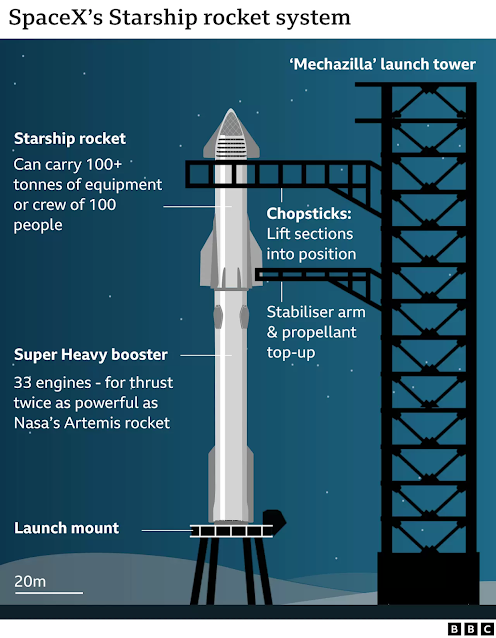 |
| Starship exploding Source: Reuters |
Elon Musk's SpaceX suffered a
setback as their latest rocket, Starship, exploded during its inaugural flight,
causing it to spin out of control and ultimately resulting in its destruction.
Despite the setback, no one was harmed in the incident, and the team is already
planning to try again in just a few months. Engineers are calling the launch a
success and are eager to review the data collected, hoping to glean valuable
insights for the next flight. As always, Musk is determined to push the limits
of space travel and is already setting his sights on the next launch.
"Congrats @SpaceX team on an exciting test launch of Starship! Learned a lot for next test launch in a few months," Mr Musk tweeted.
During the rocket's ascent, six of
the 33 engines at the base of the vehicle were shut down or failed. About three
minutes into the flight, it was clear that something was amiss as the two
halves of the rocket remained connected instead of separating as planned, and
began to tumble out of control. Finally, at four minutes into the launch, a
large explosion occurred, which is believed to have been triggered by the
computer's Flight Termination System.
 |
| Raptor 33 Engines: You can clearly see that 6 engines are not functional |
The mission plan was to send the ship on one full orbit of the Earth and then have it splash down in the Pacific Ocean. There was no plan to recover the ship or Super Heavy at this time, but the long-term goal is to land and reuse both halves repeatedly. This would be a game-changer, as the Starship can carry over 100 tonnes per flight and has a low operating cost since it only requires fuel.
The Starship's top segment, or "ship", had flown on short hops before, but this was its first launch with the lower stage. The massive lower-stage, known as Super Heavy, was test-fired in February with its engines throttled back to half their capacity. However, SpaceX aimed to use 90% thrust during Thursday's launch, which should have delivered around 70 meganewtons - double the thrust of the iconic Saturn V rocket that took humans to the Moon in the 1960s and 70s.
"We've got an arduous two or
three years ahead of us with, probably, you know, many bumps on the road, but
at the end of that, we should have something that enables a base on the Moon
and a base on Mars," Mr Musk said this week.
 |
| Source: BBC |
Elon Musk plans to use Starship to launch more satellites for his Starlink internet service. The rocket will only carry people when engineers are confident in its safety. The first mission will be commanded by billionaire Jared Isaacman, who has already flown to space with SpaceX. Another mission will take Japanese billionaire Yusaku Maezawa and eight artists around the Moon as part of his DearMoon project. NASA also wants to use Starship to land astronauts on the Moon.
 |
| Source: BBC |

Very interesting and good information and I know you have aan eye of Egle😜 keep it up
ReplyDeleteThank you
Delete